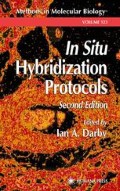Abstract
In situ hybridization takes advantage of the reaction between two complementary single-stranded nucleic acid molecules. These molecules bind by means of hydrogen bonding of complementary base pairs. Hybridization performed in situ includes techniques that detect these hybrids in a cell or tissue section by cytochemistry.
References
Gall, J. G. and Pardue, M. (1969) Formation and detection of RNA-DNA hybrid molecules in cytological preparations. Proc. Natl. Acad. Sci. USA 63, 378–383.
John, H. A., Birnstiel, M. L., and Jones, K. W. (1969) RNA-DNA hybrids at the cytological level. Nature 223, 582–587.
Buongiorno-Nardelli, S. and Amaldi, F. (1970) Autoradiographic detection of molecular hybrids between rRNA and DNA in tissue sections. Nature 225, 946–948.
Pardue, M. L. and Dawid, I. B. (1981) Chromosomal locations of two DNA segments that flank ribosomal insertion-like sequences in Drosophila: flanking sequences are mobile elements. Chromosoma 83, 29–43.
Fostel, J., Narayanswami, S., Hamkalo, B., Clarkson, S. G., and Pardue, M. L. (1984) Chromosomal location of a major tRNA gene cluster of Xenopus laevis. Chromosoma 90, 254–260.
Brahic, M. and Haase, A. T. (1978) Detection of viral sequences of low reiteration frequency by in situ hybridization. Proc. Natl. Acad. Sci. USA 75, 6125–6127.
Haase, A. T., Venture, P., Gibbs, C., and Touretellotte, W. (1981) Measles virus nucleotide sequences: detection by hybridization in situ. Science 212, 672–673.
Childs, G. V., Lloyd, J., Unabia, G., Gharib, S. D., Weirman, M. E., and Chin, W. W. (1987) Detection of LH mRNA in individual gonadotropes after castration: use of a new in situ hybridization method with a photobiotinylated cRNA probe. Mol. Endocrinol. 1, 926–932.
Childs, G. V., Unabia, G., Weirman, M. E., Gharib, S. D., and Chin, W. W. (1990) Castration induces time-dependent changes in the FSH-mRNA-containing gonadotrope cell population. Endocrinology 126, 2205–2213.
Childs, G. V., Patterson, J., Unabia, G., Rougeau, D., and Wu, P. (1991a) Epidermal growth factor enhances ACTH secretion and expression of POMC mRNA by corticotropes in mixed and enriched cultures. Mol. Cell. Neurosci. 2, 235–243.
Childs, G. V., Taub, K., Jones, K. E., and Chin, W. W. (1991b) Tri-ioodothyronine receptor β-2 mRNA expression by somatotropes and thyrotropes: effect of propyl-thiouracil-induced hypothyroidism in rats. Endocrinology 129, 2767–2773.
Childs, G. V., Unabia, G., and Rougeau, D. (1994) Cells that express luteinizing hormone (LH) and follicle stimulating hormone (FSH) beta (β) subunit mRNAs during the estrous cycle: the major contributors contain LH, FSH and/or growth hormone. Endocrinology 134, 990–997.
Kaiser, U., Lee, B. L., Unabia, G., Chin, W., and Childs, G. V. (1992) Follistatin gene expression in gonadotropes and folliculostellate cells of diestrous rats. Endocrinology 130, 3048–3056.
Lee, B. L., Unabia, G., and Childs, G. (1993) Expression of follistatin mRNA in somatotropes and mammotropes early in the estrous cycle. J. Histochem. Cytochem. 41, 955–960.
Fan, X. and Childs, G. V. (1995) EGF and TGF mRNA and their receptors in the rat anterior pituitary: localization and regulation. Endocrinology 136, 2284–2324.
McQuaid, S. and Allan, G. M. (1992) Detection protocols for biotinylated probes. Optimization using multistep techniques. J. Histochem. Cytochem. 40, 569–574.
Childs, G. V., Unabia, G., and Lloyd, J. (1992a) Recruitment and maturation of small subsets of luteinizing hormone (LH) gonadotropes during the estrous cycle. Endocrinology 130, 335–345.
Childs, G. V., Unabia, G., and Lloyd, J. M. (1992b) Maturation of FSH gonadotropes during the rat estrous cycle. Endocrinology 131, 29–36.
Wu, P. A. and Childs, G. V. (1990) Cold and novel environment stress affects AVP mRNA in the paraventricular nucleus, but not the supraoptic nucleus: an in situ hybridization study. Mol. Cell. Neurosci. 1, 233–249.
Wu, P. A. and Childs, G. V. (1991) Changes in rat pituitary POMC mRNA after exposure to cold or a novel environment detected by in situ hybridization. J. Histochem. Cytochem. 39, 843–852.
Author information
Authors and Affiliations
Editor information
Editors and Affiliations
Rights and permissions
Copyright information
© 2000 Humana Press Inc.
About this protocol
Cite this protocol
Childs, G.V. (2000). In Situ Hybridization with Nonradioactive Probes. In: Darby, I.A. (eds) In Situ Hybridization Protocols. Methods in Molecular Biology™, vol 123. Humana Press. https://doi.org/10.1385/1-59259-677-0:131
Download citation
DOI: https://doi.org/10.1385/1-59259-677-0:131
Publisher Name: Humana Press
Print ISBN: 978-0-89603-686-4
Online ISBN: 978-1-59259-677-5
eBook Packages: Springer Protocols

